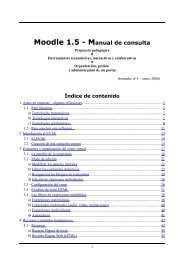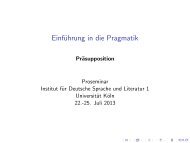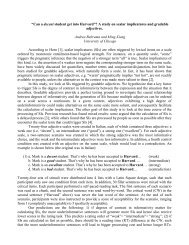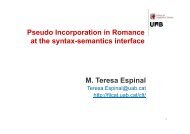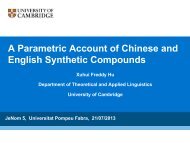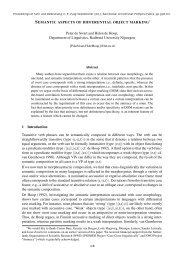Locating adpositions. - corpora@parles.upf
Locating adpositions. - corpora@parles.upf
Locating adpositions. - corpora@parles.upf
You also want an ePaper? Increase the reach of your titles
YUMPU automatically turns print PDFs into web optimized ePapers that Google loves.
24<br />
Veronika Hegeds<br />
There is a prepositional pP, and a postpositional PP; the functional projection expresses<br />
orientation, directionality, and/or proximity. This is illustrated in the following examples.<br />
(21) a. lent a völgy-ben<br />
down the valley-INE<br />
‘down in the valley’<br />
b. be az ágy alá<br />
into the bed under.to<br />
‘(to) under the bed’<br />
c. ide hoz-zám<br />
here ALL-1sg<br />
‘here to me’<br />
Again, constituency tests can be used to show that the particle and the PP do form a<br />
constituent: the pP can appear next to nominals as in (22), it can move as a constituent for<br />
example as contrastive topic (cf. (23)), it can be used as an answer (see (24)), and it can be<br />
used as the first constituent in the PP-with-DP construction (as in (25)), which is an<br />
environment where we only find directional PPs.<br />
(22) a csatorna [lent a város alatt]<br />
the tunnel down the city under.at<br />
‘the tunnel under the city’<br />
(23) [Lent a pincé-ben] nem maradt már semmi.<br />
down the cellar-INE not remained yet nothing.<br />
‘Down in the cellar, nothing is left.’<br />
(24) Hová szaladt az egér?<br />
where ran the mouse<br />
‘Where did the mouse run?’<br />
[Be az ágy alá.]<br />
into the bed under.to<br />
‘Under the bed.’<br />
(25) [ Le a pincé-be] az üres üvegek-kel!<br />
down the cellar-ILL the empty bottles-INSTR<br />
‘Down to the cellar with the empty bottles!’<br />
The tests show that spatial particles start out forming a constituent with the PPs. This,<br />
however, is often concealed by the fact that the particles obligatorily move to the preverbal<br />
position during the derivation, as we saw earlier.<br />
However, when the pP is an adjunct, the movement to the preverbal position does not have<br />
to take place, and we attest a lot of cases where the particle and the rest of the PP form a<br />
constituent. This is the case in (26), where the adjunct pP is focus, or in (27), where it remains<br />
in postverbal position.




